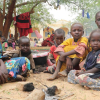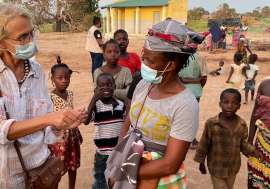Desertification a threat to Africa’s development
Desertification a threat to Africa’s development
 “The good news is at the grassroots level,” says Luc Gnacadja.
“The good news is at the grassroots level,” says Luc Gnacadja.20 years on, has the world delivered on the UNCCD?
Yes and no. Yes, because when you look at the convention there are a number of requirements and commitments. Developing country commitments were to establish action programmes to address desertification, avoiding and restoring degraded lands and mainstreaming this into national poverty alleviation and development. Developed country parties were to provide financial support and technology transfer for certain country parties to implement those national programmes. Most of the developing country parties affected by desertification have established their national action plan, so that aspect of the commitment has been made. But the failure is that plans will not go to the fields and roll back desertification, it takes implementation. Unfortunately developing countries in Africa, for instance, have not succeeded in reflecting desertification in their plans for poverty eradiation, food security or development.
Why?
Because the issue of desertification is in ivory towers in the ministries in charge of it. Desertification is more than planting trees. Desertification is first and foremost avoiding the misuse of the land, such as inappropriate use of fertilizer, the use of some crops that are not appropriate for the land, or the type of tillage that denudes [land].
In the last decade the least developed countries have experienced an average of 5 per cent GDP growth. However, this growth has not alleviated poverty or generated food security because it has not been generated using land that is often the sole asset of the poor. To deliver on poverty alleviation, we must ensure that we help the poor use the asset — land — sustainably. Africa has the potential to become a global engine for sustainable development.
Is there political will to roll out sustainable land practices?
You know, the will should be measured, especially political will. I measure political will by government investment in setting their commitments into motion, and in that regard there is a lot more governments can do. Think about the Maputo declaration to invest 10 per cent of budgets into agriculture, but [only] a few of the countries have met that. When you consider that Africa is the continent suffering the most from food insecurity, you wonder how the priorities are set. Political will calls for African governments to check their medium-term investment plans. I wish to see more coordinated investment that will address adaptation to climate change while at the same time maintaining and preserving biodiversity.
Commitment is good, but where is the action?
Governments may have had an excuse that 20 years ago they did not yet know how to monitor and measure desertification. But now they know because the science is there. Scientists have put on the table 11 indicators that not only assess the status of the land, but assess trends in the improvement in land degradation and these are globally accepted.
According to the FAO, 25 per cent of global land is highly degraded and there is only 10 per cent of land being improved. To feed 7 billion people today and 9 billion tomorrow, we need to meet 50 per cent demand of food, 45 per cent demand of energy and 35 per cent demand of water. If you take only the demand for food, we need additional farmland the size of South Africa, 120 million hectares. Where are we going to find them? That is why we need to come out of Rio+20 not with business as usual, but with a decision for business as unusual.
The good news is at the grassroots level. There are amazing success stories. We ought to reflect these success stories into our policies and institutions to enhance and measure them. Tanzania, Niger, Burkina Faso and Mali have provided some success stories. Malawi, a country perceived to be unable to feed itself, broke new ground.
Are you hopeful that in the next 20 years we will have changed course?
I am someone who believes that where there is no hope, life is not worth living. We must craft the hope that we want to live for. That is why we came to Rio. Let us not commit to lip service but to something we can monitor. We cannot wait for Rio+40 for results. We need that clear mandate to monitor land degradation and we hope this will be decided on at Rio+20.
—Africa Renewal online












